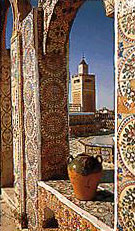NAME: Thénès or Tinès (Punic), Toun & egraves (Arabic).
LOCATION AND ACCESS: In north-eastern Tunisia, by Lake Tunis. 71 km south of Bizerte, 175 km east of Tabarka, 63 km north of Hammamet (by motorway), 142 km north of Sousse, 154 km north of Kairouan, 269 km north of Sfax, 394 km north of Gabes, 353 km north of Gafsa, 446 km north of Tozeur, via an excellent network of tarred roads.
Tourist Information: In Tunis, 1 Avenue Mohammed V. 216-1-341-077 (Office National du Tourisme Tunisien - ONTT).
One hour from Hammamet, Tunis takes you by surprise with its modern conference halls, hotels and banks, bright yellow taxis rushing passengers to a business lunch, all the hustle and bustle of a modern Mediterranean city . Steel and glass blend with the baroque, palm trees look down on chic boutiques, gardens and cafés.
Begin at the monument of November 7, which marks Tunisia's turn towards the future, stroll down shady tree lined Avenue Habib Bourguiba, with its flower stands , passing bookstores and galleries. Beyond the Cathedral and the statue of Ibn Khaldoun, looms the gateway to the ancient Medina.
As you enter the narrow streets , centuries slip away and, like Alice, step into the looking glass to another world. Small shops, their treasures of brass, olive wood, leather and brightly colored garments spill out into the street. Souvenirs, antiques, berber jewelry , carpets and pottery vie for your attention. Continue, if you can resist their lures, upwards towards the Mosque of the Olive Tree, Ez Zitouna, as old as the town itself and the heart of the Medina.
Rebuilt in the 9th century, the Ez Zitouna was for centuries the focal point of life in the Arab city as urban planning decreed the order in which the different trades were placed, and the most noble, booksellers, perfumeries, dried fruits sellers and cloth merchants held the privilege of proximity to the Mosque. Today one can still see traces of this tradition -the Souk of the Perfumes, traditional clothing shops, almond and spice sellers are still located alongside its walls.
The medina, or city, is a wealth of ancient palaces, mosques and centers of trade and learning, a living museum. Dar Ben Abdullah, Dar Hussein, Dar El Bey,Dar El Jeld, Dar El Haddad, Dar Othman, once residences of wealthy traders or ministers now house cultural centers, restaurants or government agencies.



